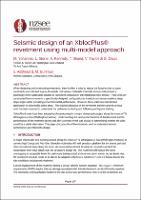| dc.contributor.author | Yohannes, Mikias | |
| dc.contributor.author | Storie, Luke | |
| dc.contributor.author | Taylor, Verity | |
| dc.contributor.author | Adshead, Sam | |
| dc.contributor.author | Shand, Tom | |
| dc.contributor.author | Davies, Brian | |
| dc.contributor.author | Kennedy, Ayse | |
| dc.contributor.author | Burrows, Madeleine | |
| dc.date.accessioned | 2023-08-28T04:23:26Z | |
| dc.date.available | 2023-08-28T04:23:26Z | |
| dc.date.issued | 2023-04-19 | |
| dc.identifier.uri | https://repo.nzsee.org.nz/xmlui/handle/nzsee/2579 | |
| dc.description.abstract | When designing and constructing revetments, there is often a drive to reduce the footprint due to space constraints and a limited supply of suitable rock armour materials. Concrete armour units present a potentially more sustainable solution to revetment construction than traditional rock armour. These units are constructed from concrete in a specifically designed configuration to interlock and remain stable at steep slope angles while providing enhanced coastal performance. However, these units have had limited application in seismically active areas. The seismic behaviour of the revetment and the concrete armour units has been assessed to understand the performance during and following earthquake shaking.
XblocPlus® units have been adopted as the armouring for a major shared path project along the shores of Te Whanganui-a-Tara (Wellington Harbour). Understanding the various mechanisms of displacement and the performance of the revetment during and after a seismic event was crucial in determining whether the units would be a viable alternative. This paper discusses the different models used to understand seismic performance and inform the design. | |
| dc.language.iso | en | |
| dc.publisher | New Zealand Society for Earthquake Engineering | |
| dc.relation.ispartofseries | 2023;107 | |
| dc.subject | Achieving resilience while accounting for uncertainties | |
| dc.title | Seismic design of an XblocPlus® revetment using multi-model approach | |
| dc.type | Article | |

